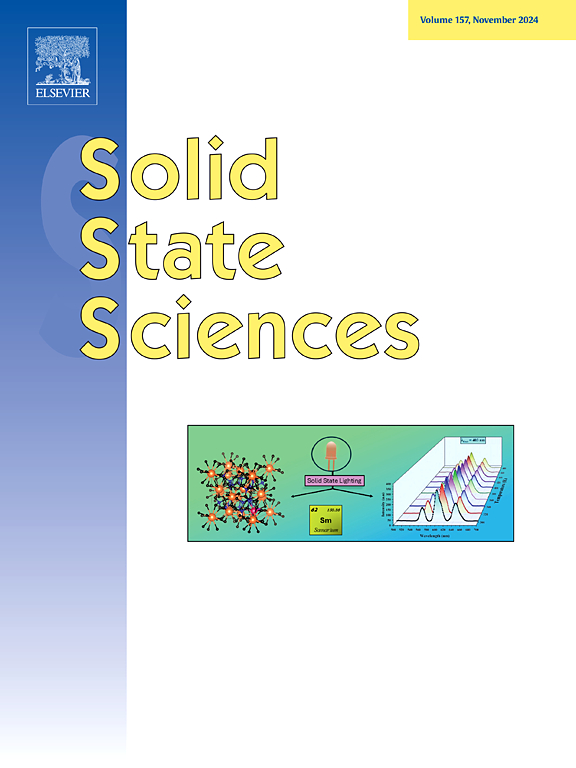具有动态电荷条纹的重费米子金属CeB6中自旋液滴(铁子)形成的证据
IF 3.3
3区 化学
Q2 CHEMISTRY, INORGANIC & NUCLEAR
引用次数: 0
摘要
在高达90 kOe的磁场中,电阻率(ρ)、导热系数(κ)和比热(C)在低温1.8−7 K下的研究,使得首次探测到重费米子CeB6六硼化物所谓的反铁四极子(AFQ)相中电荷输运和热特性的指数场依赖ρ(H)、κ−1(H)、C(H) ~ exp(−μeffH/kBT)成为可能。磁阻测量表明,在AFQ状态下,有效磁矩的变化范围为μeff(T) = 1.4 ~ 1.9μB,其值非常接近于μeff(τ)(T)≈2μB,这是由热容和导热实验中观察到的弛豫时间τ(H)的场依赖性推导出来的。本文提出的现象学模型使我们能够将磁矩归因于出现在CeB6晶体体AFQ相中的自旋液滴(铁子)。利用最大熵法对低温x射线衍射实验进行分析,揭示了在纳米尺度上电子相分离导致铁子的形成,表现为动态电荷条纹。我们认为B6团簇的Jahn−Teller集体模式是导致电荷条纹形成的原因,从而诱导Ce离子对和三重态的横向准局部振动,从而导致CeB6矩阵中的4f−5d自旋波动,提供自旋极极化子(铁子)。本文章由计算机程序翻译,如有差异,请以英文原文为准。

Evidence for spin droplets (ferrons) formation in the heavy fermion metal CeB6 with dynamic charge stripes
The presented studies of resistivity (ρ), thermal conductivity (κ) and specific heat (C) at low temperature 1.8−7 K in magnetic field up to 90 kOe made it possible to detect for the first time the exponential field dependences ρ(H), κ −1(H), C(H) ∼ exp(−μeffH/kBT) of the charge transport and thermal characteristics in the so-called antiferroquadrupole (AFQ) phase of the archetypal heavy-fermion CeB6 hexaboride. From magnetoresistance measurements it is shown that in the AFQ state the effective magnetic moment varies in the range μeff(T) = 1.4−1.9μB, and its value is very close to μeff(τ)(T) ≈ 2μB, derived from the field dependence of the relaxation time τ(H) observed in the heat capacity and thermal conductivity experiments. The phenomenological model proposed here allowes us to attribute the magnetic moments to spin droplets (ferrons), that appear in the bulk AFQ phase of CeB6 crystals. The relevant electronic phase separation at the nanoscale, manifested by dynamic charge stripes, that leads to the formation of ferrons, was revealed from the analysis of low-temperature X-ray diffraction experiments using the maximum entropy method. We argue that the Jahn−Teller collective mode of B6 clusters is responsible for the formation of charge stripes formation inducing transverse quasi-local vibrations of pairs and triplets of Ce ions, which leads to 4f−5d spin fluctuations providing spin-polarons (ferrons) in the CeB6 matrix.
求助全文
通过发布文献求助,成功后即可免费获取论文全文。
去求助
来源期刊

Solid State Sciences
化学-无机化学与核化学
CiteScore
6.60
自引率
2.90%
发文量
214
审稿时长
27 days
期刊介绍:
Solid State Sciences is the journal for researchers from the broad solid state chemistry and physics community. It publishes key articles on all aspects of solid state synthesis, structure-property relationships, theory and functionalities, in relation with experiments.
Key topics for stand-alone papers and special issues:
-Novel ways of synthesis, inorganic functional materials, including porous and glassy materials, hybrid organic-inorganic compounds and nanomaterials
-Physical properties, emphasizing but not limited to the electrical, magnetical and optical features
-Materials related to information technology and energy and environmental sciences.
The journal publishes feature articles from experts in the field upon invitation.
Solid State Sciences - your gateway to energy-related materials.
 求助内容:
求助内容: 应助结果提醒方式:
应助结果提醒方式:


